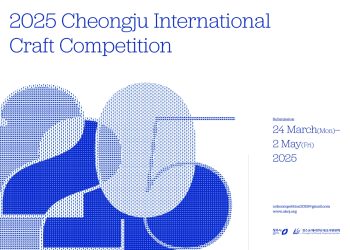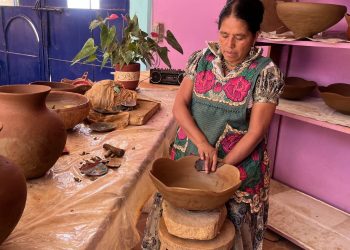






Ceramics as a vehicle for messages: the 18th Parcours Céramique Carougeois
The Parcours Céramique Carougeois (PCC), one of Europe’s pioneering biennials of contemporary ceramics, is celebrating its 35th anniversary this year. The theme of the 18th Parcours Céramique Carougeois is ‘Writing, images, messages’, with around twenty exhibitions scheduled from 14 to 22 September 2024 in the arcades and galleries of Carouge, near Geneva, Switzerland. Whether their approach is one of commitment or aesthetic research, the selected artists are treating the question of meaning. Stephanie Marie Roos, guest of honour at this 18th edition, and ceramists such as Réjean Peytavin, Caroline Andrin and Line Dutoit Choffet, combine different languages, multiplying repertoires and references in works that remind us of the infinite plasticity of the clay as medium.
Over the past 35 years, the Parcours Céramique Carougeois has become one of the world’s leading ceramics events. Organised by the Bruckner Foundation – Ceramic Centre, a partner of international shows such as C-14 Paris, the PCC has grown into a stage watched by both collectors and lovers of creative ceramics, hoping to spot emerging talents. The high standards and quality of its programme are now widely recognised. ‘The strength of the PCC lies in its collective networking,’ says Emilie Fargues, head of the Bruckner Foundation. ‘The involvement of people who are passionate about their work, and the fact that the exhibitions are like a stroll through the old town of Carouge, have certainly helped to ensure that this event will continue.’
For its 18th edition, the PCC has teamed up with curator Frédéric Bodet, former curator at the National Museum of Sèvres, to build its programme around the theme of ‘Writings, images, messages’. The artists in the programme from 14 to 22 September offer their own vision and presence in the world, whether it’s to shed light on a societal debate, make a commitment or fuel aesthetic research.
Stephanie Marie Roos, guest of honour
Rising ceramic star Stephanie Marie Roos (DE) is the author of an abundant body of work that resonates in every way with this theme. Her work explores the iconic power of images as symbols of identity, cultural references and means of protest. Although Stephanie Marie Roos does not describe herself as a political artist, her work as a whole shows her observation of her time. Gender issues, the demands of oppressed groups, the rise of the extreme right and ultraliberalism are all part of her work. These are all phenomena that she captures through iconographic research and immersive analysis of photographs, in which she succeeds marvellously in capturing the significant details.
Between the ‘I’ and the ‘we’, the German artist demonstrates her fascination by the complexity of individuals as socio-cultural beings. While the figures she creates are archetypal in scope, she is far from the idea of reinforcing stereotypes. What interests her, on the contrary, is expressing ‘in the manner of a kaleidoscope’ the multiple facets of a person: ‘It’s not a question of reconstructing the forms of reality in clay, but of showing something that’s hidden behind it’, she stresses. Between our self-image and social expectations, between our desperate desire to belong and our search for an identity, how do we define ourselves? Beneath the determined or elusive appearance of her figures we can read a certain cultural determinism, as well as the vulnerability that arises from these tensions.
‘Vasomancy’ performance
Multi-talented artist Réjean Peytavin (FR) is exploring a different relationship with the world by staging an alternative version of globalisation. Starting with the observation of archaeological vases, he uses them in all their forms to create a dialogue between cultures and eras. His pieces are the fruit of a collaborative approach, starting with chalk and watercolour drawings that he sends to a Moroccan weavers’ cooperative, who reproduce them in the stitches of their kilims. From 2D to relief, the artist then moves on to volume, in ceramic vases whose elegant yet playful texture mimics the carpets. It is this interplay of reproduction, transmission and reinterpretation that Réjean Peytavin has dubbed ‘Traduslation’.
As part of the PCC, Réjean Peytavin is also presenting an original performance. Inspired by clairvoyance sessions, he is inviting spectators to take part in individual ‘Vasomancy’ sessions to read ‘the vase inside you’. Each person will be able to leave with the drawing that the artist has seen in them.
Deciphering writing, images and messages
Aimed at laymen and initiates alike, the PCC focuses on the inclusion and accessibility of the works, with the aim of highlighting the growing importance of so-called slow techniques in the visual arts and promoting ceramics to a wide audience. To help visitors decipher the writing, images and messages at work in the artists’ work, it is offering four visits to the Parcours in the form of guided tours.
Estelle Gassmann (CH), Stephanie Marie Roos (DE) and Thibaut Renoulet (FR) will be on hand at the PCC to explain their approach, while Caroline Andrin (BE), Sangwoo Kim (KR) and Line Dutoit Choffet (CH) will be unveiling their approaches and techniques in public exhibitions.
A constellation of partners
While the heart of the PCC beats in Carouge, it is also extending its reach to other locations in Geneva through several partnerships. In addition to a pop-up store run by members of Swissceramics, the umbrella association of Swiss ceramics representatives is organising an exhibition of the best final-year works from several ceramics training centres in Switzerland. Among other partner institutions, the Ariana Museum of Ceramics and Glass is also on the PCC programme with four exhibitions, two of which highlight its acquisition policy.
Traditionally, the launch of the PCC follows the announcement of the prizes awarded by the Museum of Carouge at the end of its International Ceramics Competition. This year, on Saturday 14 September, the prizes will be awarded to three works presented on the theme of ‘La fête’ (the celebration), to mark the museum’s 40th anniversary. On Sunday 22 September, the 18th edition will close with the announcement of the works selected by the PCC to receive prizes from the Bruckner Foundation and the Ariana Museum.
The full programme and practical information can be found at www.parcoursceramiquecarougeois.ch
Captions
- Parcours Céramique Carougeois 2024 Poster. Artwork by Stephanie Marie Roos. Design by Superposition – Vincent Schambacher.
- STEPHANIE MARIE ROOS, Echo, 2020, Stoneware, oxides, ceramic decals, gold, 65 x 31 x 27 cm / Narziss, 2020, Stoneware, glaze, émail, ceramic decals, platinum, 68 x 48 x 30 cm. Photo: Stephanie Marie Roos. Exhibition at Maison Pertin
- RÉJEAN PEYTAVIN, Skupaj, 2022, Oil pastel on paper, 65 x 99 cm. Photo: Tanguy Beurdeley. Performance « Vasomancy » at Galerie h
- BODIL MANZ, Construction with red, 2024, Cylinder n° 5, porcelain, 19 x 23 cm. Photo: Jeppe Sørensen. Exhibition at Galerie Ligne Treize
- SANGWOO KIM, Vent, Stoneware, porcelain slips, 64 x 58 x 47 cm. Exhibition at Aubert Jansem Galerie
- HERVÉ ROUSSEAU, Monolithe, Stoneware, engobe, wood firing, 55 x 30 cm. Photo: P. Vangysel. Exhibition at Atelier Maison Potter
- TIDRU, Les bruits du cœur, Vivre chez eux, Mariage mixte, 2023, Terracotta, engobe, mixed drawing techniques (watercolor, colored pencils, collage), 50 cm, 45 cm et 45 cm. Photo: Chloé Cottalorda. Exhibition at Galerie Séries Rares

















